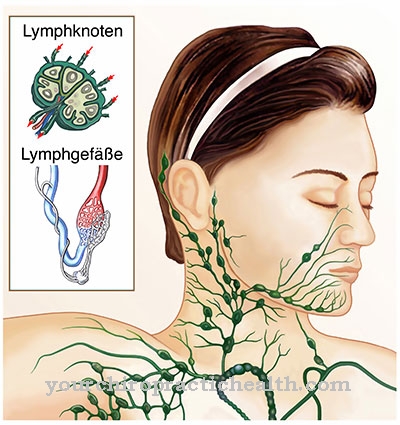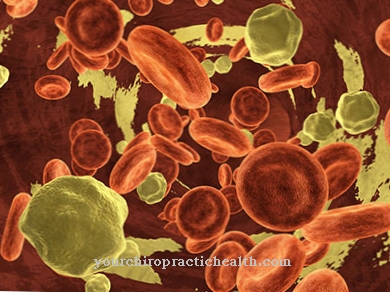The Tangier disease is an extremely rare hereditary disease among around 100 documented cases so far. Patients with this disease suffer from a disorder of lipid metabolism and a reduced production of HDL cholesterol. So far there are no causal therapy methods for the treatment of Tangier disease.
What is Tangier Disease?

© Giovanni Cancemi - stock.adobe.com
In the Tangier disease it is an extremely rare genetic defect. This defect triggers a disturbance in lipid metabolism. So far, hardly more than 100 people have been reported to be affected. In 1961, D. S. Frederickson named the disease after the island of Tangier. Back then, the only documented patients came from this island. Tangier's disease is associated with an impaired release of cholesterol from the body's cells.
As a result, fewer high-density lipoproteins are formed. These so-called HDL proteins mainly remove cholesterol. The removal of cholesterol is disrupted as a result of the low HDL proteins and the substance is increasingly stored in the reticular connective tissue. The specialist literature sometimes also refers to the hereditary disease as An-α-lipoproteinemia, as familial HDL deficiency or as familial hypoalphalipoproteinemia.
causes
The hereditary disease of familial HDL deficiency is inherited in an autosomal recessive manner. This means that the disease can only be passed on from two partners with the defect. The causative genetic defect is presumably on the long arm of chromosome nine and relates to the ABCA 1 gene. This ABCA 1 gene is responsible for the coding for transport proteins that are involved in the removal of cholesterol from the body's cells.
Medicine differentiates between carriers of the defect and those who are actually sick. If both the mother and the father carry the genetic defect, there is a one in four chance of the birth of a sick child. The probability of children with the defect is two to four and the probability of completely healthy offspring is given, like that of a sick child, with a ratio of one to four.
Symptoms, ailments & signs
The main symptom of Tangier's disease are yellow-orange patches of skin. They lie mainly on the lymphatic organs of the skin of the mouth and throat. The almonds in particular are affected by the discoloration caused by stored cholesterol. Sometimes they are enlarged along with the rest of the mouth and throat lymphatic space. Likewise, enlargements of the internal organs can sometimes occur in the context of Tangier's disease.
This mainly refers to enlargements of the liver and spleen or the pancreas. Sometimes the patient's low HDL level also leads to arteriosclerosis, i.e. calcification of the veins. As a result, corneal opacity or anemic blood count changes can occur.
Neurological symptoms were reported somewhat less frequently in addition to the symptoms mentioned. Initially, this mainly includes muscle weaknesses and sensory and movement disorders of the arms and legs. The neurological symptoms are usually regressive, but often return over time. As a rule, they affect individual nerves in the peripheral nervous system.
Diagnosis & course of disease
The first suspicion of Tangier disease may overtake a doctor during the eye diagnosis. Visual diagnostics typically show yellow-orange changes in the mucous membrane. In the serum, the physician uses total cholesterol, HDL cholesterol and apolipoprotein A-I as indicators of the disease. In lipoprotein electrophoresis, for example, no α or pre-β bands are found. With regard to the cholesterol level, values below 100 mg / dl are an indication of Tangier's disease.
At the same time, HDL cholesterol cannot be made out at all or has a faulty structure. In addition, there is often low apolipoprotein A-II. A human genetic examination often confirms the diagnosis. Nerve biopsies may be required for forms with neurological failures. These biopsies usually show a regression of myelinated and unmyelinated axons. By and large, the prognosis for Tangier disease is relatively favorable. If vascular or cardiovascular diseases occur in adulthood, the prognosis is somewhat less favorable.
Complications
The most serious complication of Tangier's disease is the overgrowth of internal organs. During the course of the disease or from birth, the liver and spleen become enlarged, and rarely the pancreas. This causes a number of complaints such as symptoms of poisoning, hormonal fluctuations or metabolic disorders, which in turn are associated with serious complications.
If arteriosclerosis is found, permanent damage has usually already developed. This usually leads to corneal opacity, anemic blood count changes and neurological complaints. Muscle weakness as well as sensory and movement disorders of the arms and legs are typical. In the absence of treatment, permanent deformities and serious illnesses set in.
In the most severe cases, circulatory collapse or even heart failure and ultimately death of the patient occur. The treatment of this rare hereditary disease is also not risk-free. Under certain circumstances, gene therapy can cause serious illnesses, for example cancers such as leukemia.
Finally, when a virus is transduced, there is a risk that the patient will become infected with the virus used as a ferry. Such an infection is usually fatal or at least has serious health consequences.
When should you go to the doctor?
In Tangier's disease, the person concerned depends on a visit to a doctor. Further complications and complaints can only be avoided through correct and, above all, early treatment. An early diagnosis has a positive effect on the further course. Therefore, a doctor should be consulted at the first symptoms and symptoms of Tangier disease. The doctor should then be consulted if the person concerned suffers from various symptoms of the eyes.
The cornea of the eye usually becomes cloudy. If these symptoms occur for no particular reason and do not go away on their own, a doctor must be consulted in any case. Sudden muscle weakness or movement disorders can also indicate Tangier's disease and should also be checked by a doctor.
As a rule, Tangier's disease can be diagnosed and treated by a general practitioner or an orthopedic surgeon. However, the further course depends heavily on the time of diagnosis, so that no general prediction is possible.
Treatment & Therapy
There are hardly any therapeutic measures available to date for the treatment of Tangier diseases. This is due on the one hand to their genetic causes and on the other hand to their rarity, which also allows only limited research. So far, a nutrition plan is one of the few therapeutic approaches for Tangier disease. A low-fat diet in particular is recommended for all forms of the hereditary disease, but the change in diet does not correspond to causal therapy.
In terms of causal therapy, genetic engineering forms of therapy may be conceivable in the future.This genetic treatment would take place as part of gene therapy and could possibly replace the defective gene with a healthy one. Gene therapies have already been successfully carried out on humans in the context of clinical studies. On the other hand, several deaths have been reported in connection with gene therapy studies on living humans.
In view of this, gene therapy is still in its infancy and is currently (as of 2015) one of the most important research areas in medicine. Because of the rarity of Tangier's disease, gene therapy studies in direct connection with the disease have never been carried out.
prevention
Tangier disease cannot be prevented. However, parents-to-be or couples planning their children can theoretically be examined for the genetic defect via a sequence analysis of their DNA. In this way, the risk for a child with Tangier's disease can at least be better assessed.
Aftercare
Since Tangier disease is a very rare hereditary disease and is based on a genetic defect, the possibilities for self-treatment are rather limited. However, dietary measures have proven to be positively effective in this disease: The diet of the person affected should above all be low in fat. Dietary supplements help to compensate for nutritional deficiencies.
Raw and healthy foods dominate the menu. Heavy foods that could raise cholesterol should be avoided if possible. Medicines that have a negative effect on the cholesterol level must also be discontinued in consultation with the doctor and replaced with alternative medications. A healthy lifestyle can have a positive effect on the general well-being of the patient.
This includes getting enough sleep, moderate exercise, and avoiding stress. Luxury foods such as alcohol and nicotine should be avoided as far as possible. It is important for the sick to take their medication according to the doctor's prescriptions and to find out about possible interactions and side effects so that appropriate measures can be taken if necessary.
A causal treatment of Tangier disease is not yet possible. Various genetic therapies are currently being tested that may promise a cure for this disease in the future. Those affected should find out about these options from their treating doctor in order to be able to participate in current test programs.
You can do that yourself
Dietary measures in the first place must be followed by those with Tangier disease. A low-fat diet and the use of nutritional supplements are recommended. The menu should mainly consist of raw vegetables and healthy foods. Luxury foods such as alcohol, nicotine or caffeine should be avoided as well as particularly heavy foods that increase the cholesterol level. This also includes certain medications that must be stopped in consultation with the doctor.
In addition, general measures such as sufficient exercise, plenty of sleep and avoiding stress are important. Sick people must also take the prescribed medication according to the doctor's instructions and inform them of any side effects and interactions so that the necessary countermeasures can be initiated at an early stage. In addition, you should consult with other specialists, such as nutritionists and alternative doctors, who can support the treatment of the pain.
Tangier disease cannot yet be treated causally. However, genetic engineering forms of therapy are currently being tested which could enable a cure in the future. Affected people should talk to their family doctor about these options and, if necessary, take part in current test programs.





.jpg)



.jpg)



.jpg)



.jpg)







.jpg)


